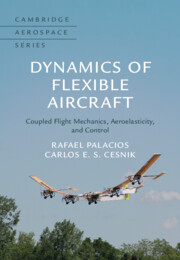Book contents
- Frontmatter
- Dedication
- Contents
- Preface
- Symbols
- 1 Introduction
- 2 The Nonstationary Atmosphere
- 3 Dynamics of Elastically Supported Rigid Airfoils
- 4 Dynamics of Rigid Aircraft in a Nonstationary Atmosphere
- 5 Dynamics of Flexible Aircraft with Quasi-Steady Deformations
- 6 Dynamics of Flexible Aircraft with Small-Amplitude Vibrations
- 7 Time-Domain Unsteady Aerodynamics for Low-Speed Flight
- 8 Geometrically Nonlinear Composite Beams
- 9 Dynamics of Very Flexible Aircraft
- 10 Feedback Control
- Experimental Testing
- Appendix A The Fourier Transform
- Appendix B Von Kármán Model for Isotropic Turbulence
- Appendix C Finite Rotations
- References
- Index
3 - Dynamics of Elastically Supported Rigid Airfoils
Published online by Cambridge University Press: 29 June 2023
- Frontmatter
- Dedication
- Contents
- Preface
- Symbols
- 1 Introduction
- 2 The Nonstationary Atmosphere
- 3 Dynamics of Elastically Supported Rigid Airfoils
- 4 Dynamics of Rigid Aircraft in a Nonstationary Atmosphere
- 5 Dynamics of Flexible Aircraft with Quasi-Steady Deformations
- 6 Dynamics of Flexible Aircraft with Small-Amplitude Vibrations
- 7 Time-Domain Unsteady Aerodynamics for Low-Speed Flight
- 8 Geometrically Nonlinear Composite Beams
- 9 Dynamics of Very Flexible Aircraft
- 10 Feedback Control
- Experimental Testing
- Appendix A The Fourier Transform
- Appendix B Von Kármán Model for Isotropic Turbulence
- Appendix C Finite Rotations
- References
- Index
Summary
The equations of motion for an elastically-supported airfoil are first derived. This is followed by a extensive review of the classical results of linear unsteady aerodynamics. State-space realizations are then introduced for those solutions, which result in time-domain formulations in dynamic aeroelasticity. They are used to introduce basic aeroelastic concepts, including flutter, divergence, and response to discrete gusts and continuous turbulence.
Information
- Type
- Chapter
- Information
- Dynamics of Flexible AircraftCoupled Flight Mechanics, Aeroelasticity, and Control, pp. 73 - 132Publisher: Cambridge University PressPrint publication year: 2023
